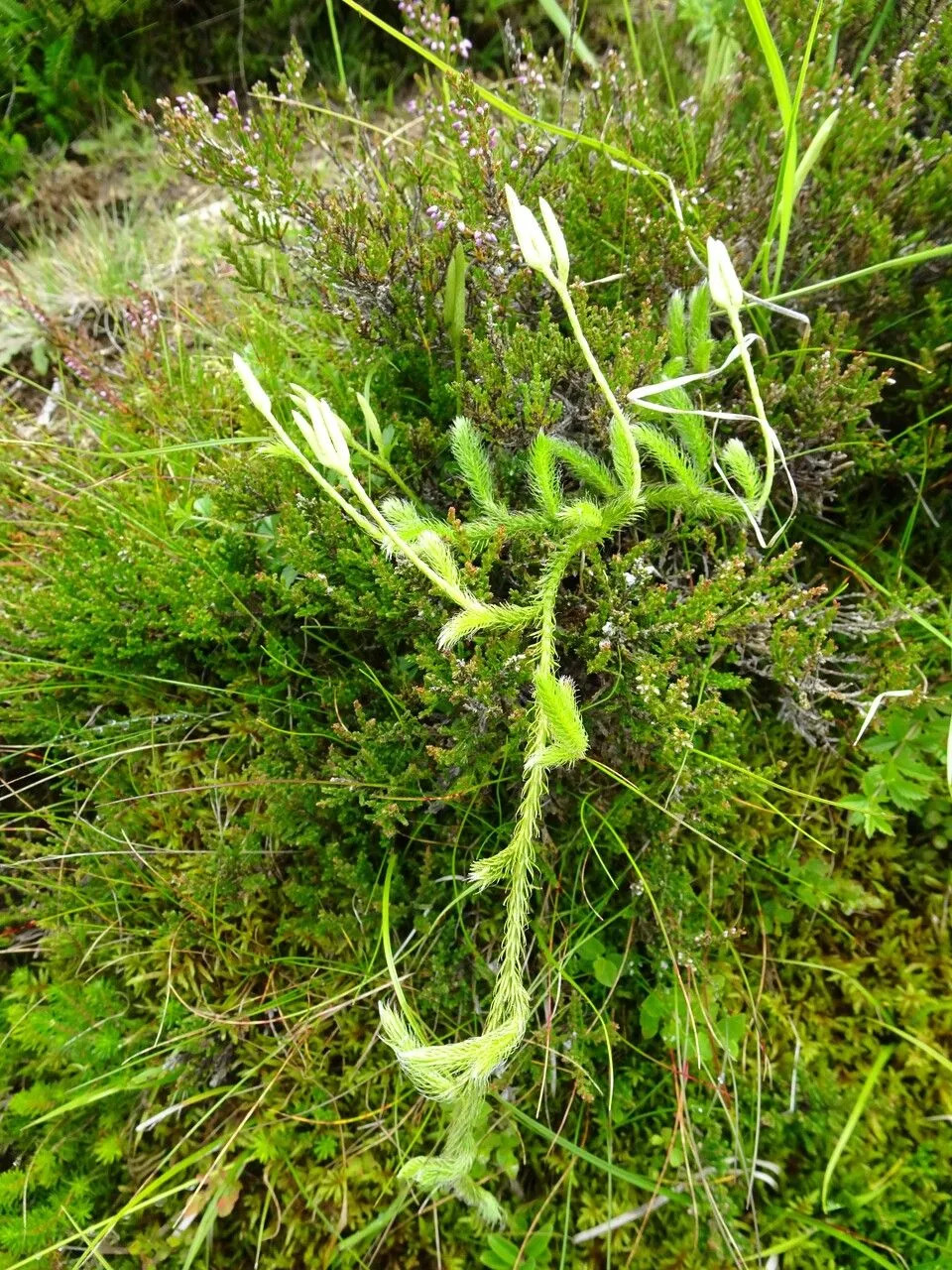
Author: L.
Bibliography: Sp. Pl.: 1101 (1753)
Year: 1753
Status: accepted
Rank: species
Genus: Lycopodium
Vegetable: False
Observations: Temp. Northern Hemisphere to Trop. Mts.
Ground-pine, known scientifically as Lycopodium clavatum, is an intriguing and widespread plant that has captured the interest of botanists and naturalists alike. This species, cataloged by the renowned botanist Carl Linnaeus in his seminal work “Species Plantarum” in 1753, exhibits a fascinating blend of resilience and adaptability.
Habitually found across the temperate regions of the Northern Hemisphere, Lycopodium clavatum extends its range into tropical mountainous regions, showcasing its versatility. This extensive geographical distribution indicates the plant’s ability to thrive under diverse climatic conditions, from cooler northern climates to more varied tropical high-altitude environments.
A member of the family Lycopodiaceae, the ground-pine is characterized by its creeping, evergreen stems that form dense tufts or mats on the forest floor. These mats are often composed of intricately branched rhizomes which give rise to upright stems. Each stem is adorned with small, needle-like leaves that are bright green and convey a pine-like appearance, hence the common name “ground-pine.”
One of the most distinct features of Lycopodium clavatum is its reproductive strategy. Producing spores in cone-like structures called strobili, this plant has a reproduction cycle well-adapted to its environmental contexts. These spores are not confined to a single geographical location but can disperse over wide areas, promoting genetic diversity and the colonization of new habitats.
Lycopodium clavatum has been historically significant for its various uses. Traditionally, the spores, known as “lycopodium powder,” have been employed for their highly flammable properties in fireworks and as a flash powder in early photography. Furthermore, these spores have also found a place in herbal medicine, although such uses require careful handling due to the potential for toxicity.
Overall, ground-pine stands as a testament to the incredible adaptability and resilience of the plant kingdom. Its presence across a broad spectrum of environments, coupled with its unique botanical properties, makes Lycopodium clavatum an enduring subject of study and admiration within the botanical community.
Dan: almindelig ulvefod
Ltz: blëtzpolleverkraut, keulen-äerdmoss
Eng: common club moss, common club-moss, elk-moss, ground-pine, running club-moss, running clubmoss, running-pine, staghorn club-moss, stag’s-horn clubmoss, common clubmoss, elkmoss, running ground-pine, staghorn clubmoss, wolf’s-claw clubmoss
Deu: keulen-bärlapp
Nld: grote wolfsklauw
Swe: katinlieko, mattlummer
Fin: katinlieko
Nor: kraake-fod, kraakefod-mose, lodden kraakefoot, løen kraakefoot, ræve-rever
Fra: lycopode en massue, lycopode claviforme, courants verts
Nno: mjuk kråkefot
Nob: myk kråkefot
Lav: vališu staipeknis
Sme: suhkkessohterássi, beatnatgieldá, buvssábáinná, buvssáváhcu
Cym: cnwbfwsogl corn carw, cnwp-fwsogl corn carw, cnwpfwsogl corn carw, cnwpfwsogl corn hydd, corn carw’r mynydd, palf y blaidd
En: Ground-pine, Running club-moss, Running-pine, Common club-moss, Staghorn club-moss, Elk-moss, Common club moss, Running clubmoss, Stag’s-horn Clubmoss, Common clubmoss, Elkmoss, Running ground-pine, Staghorn clubmoss, Wolf’s-claw clubmoss, Wolf’s Claw, Running Ground Pine
Ca: Licopodi
Cs: Plavuň vidlačka
Da: Almindelig ulvefod
Nl: Grote wolfsklauw
Fi: Katinlieko
Fr: Lycopode en massue, Lycopode claviforme, Courants verts, Lycopode à massue, Lycopode officinal, Éguaire, Selaginelle fausse sélaginelle, Sélaginelle épineuse
De: Keulen-Bärlapp, Keulenbärlapp, Keulenförmiger Bärlapp, Kolbenbärlapp
It: Erba strega, Licopodio clavato
Ja: Hikage-no-kazura
Lv: Vališu staipeknis
Lb: Blëtzpolleverkraut, Keulen-Äerdmoss
Se: Suhkkessohterássi, Beatnatgieldá, Buvssábáinná, Buvssáváhcu, Idni
No: Kraake-fod, Kraakefod-mose, Lodden kraakefoot, Løen kraakefoot, Ræve-rever
Nb: Myk kråkefot
Nn: Mjuk kråkefot
Sk: Plavúň obyčajný
Es: Pie de lobo
Sv: Mattlummer, Katinlieko
Cy: Cnwbfwsogl Corn Carw, Cnwp-Fwsogl Corn Carw, Cnwpfwsogl Corn Carw, Cnwpfwsogl Corn Hydd, Corn Carw’r Mynydd, Palf y Blaidd
Taken Aug 8, 2021 by HeyZeus (cc-by-sa)
Taken Jun 20, 2007 by Tela Botanica − Liliane Roubaudi (cc-by-sa)
Taken Jan 16, 2011 by Tela Botanica − Yoan MARTIN (cc-by-sa)
Taken Sep 13, 1883 by Tela Botanica − Anne-Marie GRIMAUD (cc-by-sa)
Taken Aug 27, 2016 by huy HO (cc-by-sa)
Taken Oct 3, 2015 by Tela Botanica − Liliane ROUBAUDI (cc-by-sa)
Taken Oct 3, 2015 by Tela Botanica − Liliane ROUBAUDI (cc-by-sa)
Taken Dec 19, 2015 by Tela Botanica − Yoan MARTIN (cc-by-sa)
Taken Dec 19, 2015 by Tela Botanica − Yoan MARTIN (cc-by-sa)
Taken Aug 27, 2016 by huy HO (cc-by-sa)
Taken Oct 31, 2016 by Tela Botanica − Liliane ROUBAUDI (cc-by-sa)
Taken Aug 26, 2017 by Tela Botanica − Sylvain PIRY (cc-by-sa)
Taken Aug 21, 2018 by Tela Botanica − Liliane Roubaudi (cc-by-sa)
Taken Aug 28, 2011 by Reinhard Bachmann (cc-by-sa)
Taken Jul 29, 2021 by Alain Bigou (cc-by-sa)
Taken Jul 28, 2014 by Tela Botanica − Jean-Jacques HOUDRÉ (cc-by-sa)
Taken Dec 19, 2015 by Tela Botanica − Yoan MARTIN (cc-by-sa)
Taken Jul 29, 2021 by Alain Bigou (cc-by-sa)
Taken Jul 29, 2021 by Alain Bigou (cc-by-sa)
Taken Jul 29, 2021 by Alain Bigou (cc-by-sa)
Taken Apr 6, 2021 by Martin Pelanek (cc-by-sa)
Taken Jul 29, 2021 by Alain Bigou (cc-by-sa)
Taken Jul 29, 2021 by Alain Bigou (cc-by-sa)
Taken Nov 22, 2022 by gisèle Friso (cc-by-sa)
Taken Jun 12, 2022 by Véronique Ruth (cc-by-sa)
Taken Aug 17, 2022 by Emmanuel (cc-by-sa)
Taken Jan 1, 1970 by Endemia – Rémy Prelli (cc-by-nc)
Taken Jul 23, 2022 by Костя Молот (cc-by-sa)
Taken Sep 24, 2017 by Yoan MARTIN (cc-by-sa)
Taken Sep 24, 2017 by Yoan MARTIN (cc-by-sa)
© copyright of the Board of Trustees of the Royal Botanic Gardens, Kew.
© copyright of the Board of Trustees of the Royal Botanic Gardens, Kew.
© copyright of the Board of Trustees of the Royal Botanic Gardens, Kew.
Growth habit: Subshrub, Forb/herb
Ph maximum: 4.5
Ph minimum: 4.0
Light: 8
Atmospheric humidity: 5
Bloom months: [‘jul’, ‘aug’, ‘sep’]
Soil nutriments: 1
Family: Myrtaceae Author: (F.Muell.) K.D.Hill & L.A.S.Johnson Bibliography: Telopea 6: 402 (1995) Year: 1995 Status:…
Family: Rubiaceae Author: Pierre ex A.Froehner Bibliography: Notizbl. Bot. Gart. Berlin-Dahlem 1: 237 (1897) Year:…
Family: Sapindaceae Author: Koidz. Bibliography: J. Coll. Sci. Imp. Univ. Tokyo 32(1): 38 (1911) Year:…
Family: Asteraceae Author: A.Gray Bibliography: Pacif. Railr. Rep.: 107 (1857) Year: 1857 Status: accepted Rank:…
Family: Fabaceae Author: Medik. Bibliography: Vorles. Churpfälz. Phys.-Ökon. Ges. 2: 398 (1787) Year: 1787 Status:…
Family: Aspleniaceae Author: (Cav.) Alston Bibliography: Bull. Misc. Inform. Kew 1932: 309 (1932) Year: 1932…